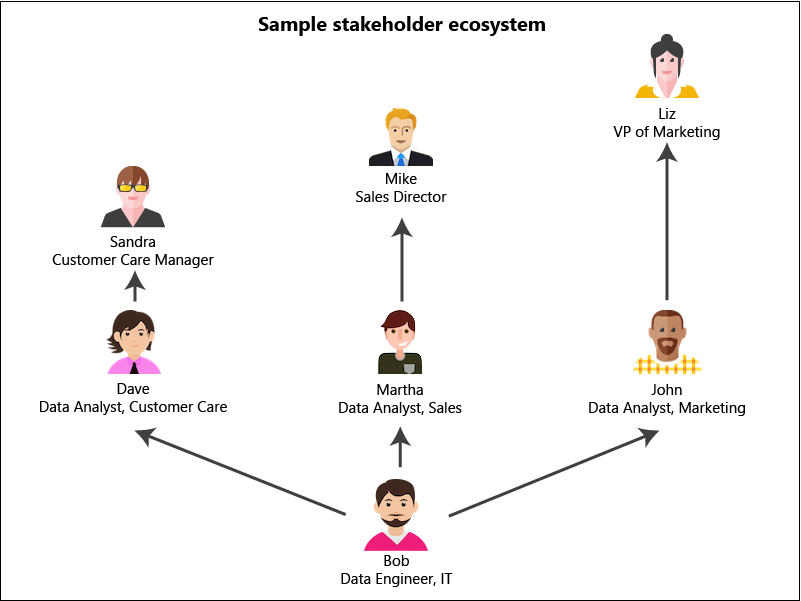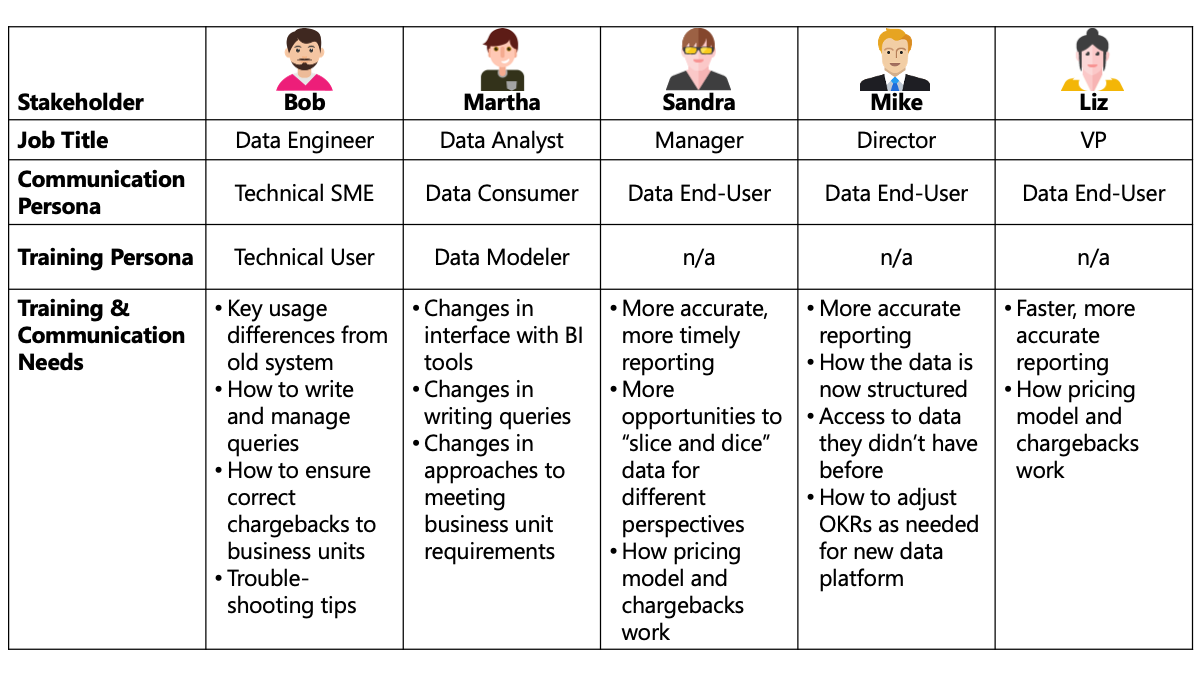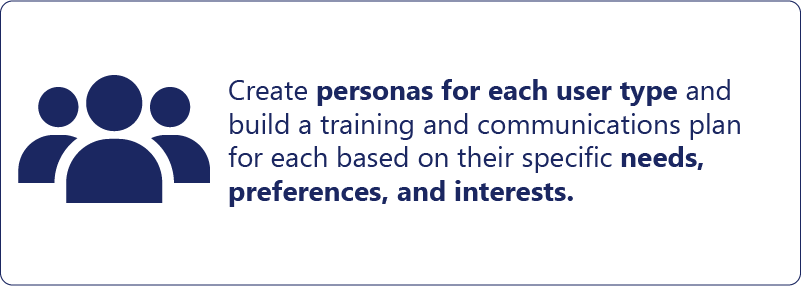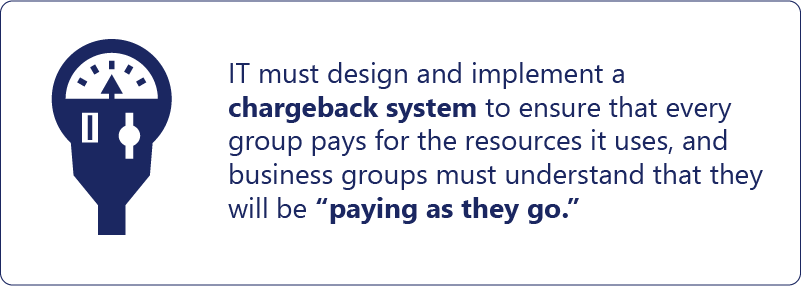8-minute read
When an enterprise decides to migrate to a cloud-based data warehouse platform, it’s easy to get excited about the foreseen advantages (lower overall cost, improved speed and performance, etc.) and to become wrapped up in the technical side of the transition. While technical due diligence is a vital part of planning (see our article on migration best practices), it’s equally important to tend to the corresponding human factors—user education, adoption, and understanding—through a well-thought-out and well-executed change management strategy.
All too often, organizations leave change management as almost an afterthought to be addressed once the technical transition to the new platform is complete. However, if users don’t understand what the change is, why it’s a good thing, and how it affects their work on Day One, the benefits of the transition will be delayed … if they are realized at all.
In this article, we’ll share three change management consulting best practices for ensuring a successful change management strategy in migrating to a cloud-based data warehouse.
Change management consulting pro tip #1: Conduct a comprehensive strategic change assessment
Any change management consulting pro will affirm that the ecosystem of stakeholders for your data migration goes beyond the front-end users who actually log on to the system. Gaining buy-in from end users of the data—the business users who receive the reports and use the data to make strategic decisions—is no less important.

When our change management consulting teams work with clients, we usually start our assessment by asking the front-end users of the platform whom they communicate with and/or send reports to, then we talk to those stakeholders and ask them the same question, and we repeat the process up the org chart. This gives us a complete picture of the stakeholder ecosystem and enables us to take into account the needs and preferences of each user group, from the data engineer to the data analyst all the way up to the C-suite.
Having a good grasp of your stakeholder ecosystem will also support an agile delivery model—specifically, in helping you determine when the platform will be rolled out to different user groups. In the above example, Marketing may have the largest number of users to be onboarded, so you may want to place them at the head of the line to build up some momentum in the organization. Or you may decide to start with smaller groups to get some quick (and lower-risk) wins in your column before moving on to larger teams. Each approach has its benefits, and considering the rollout schedule early in the process will enable you to make the best strategic decisions for your organization.
The assessment stage is also a good time to look at the overall quality of queries that are being submitted to the existing platform. Remember, cloud-based data warehouses have a per-use pricing model, and bad inquiries will amount to wasted dollars in a post-transition environment.
In one case, when one of our change management consulting experts asked our client’s IT team to assess the queries that had been submitted to the old platform, he learned that nearly one-third of them would never have yielded any usable results and probably would have crashed if hooked up to a dashboard. If the client had been using a cloud-based data warehouse at the time, those queries would have incurred a cost while delivering zero benefit. This discovery highlighted the need for rigorous governance once the new platform was in place and an opportunity to educate users on the correct procedures for query writing.

Change management consulting pro tip #2: Create personas and target training and communications for each
Once you have a grasp of the stakeholder environment, you’ll want to create personas for each user type and build a training and communications plan for each based on their specific needs, preferences, and interests. Hands-on users, for example, will need to understand the reason for the change, how it benefits them, how to use the new platform, and how it integrates with other tools such as their BI application. And while the business users who receive the reports don’t need to know details about how the platform works, they will need to understand what is changing and why it’s a good thing from their perspective.
To begin building personas, our change management consulting teams look at each stakeholder and how they interact with the data. Are they interested in where the data is coming from or how it’s being handled? Do they need to understand how their reports might look different? Do they need to know key differences in how the new data warehouse platform will interact with their existing BI tools? What do they need to know about the consumption-based pricing model (more on this below) and how it impacts them?
As you analyze your stakeholders, it will become clear that the training and communication needs are different for each group; in fact, some may not need formal training at all. When our change management consulting teams work with clients, we develop two general types of personas:
• Communication personas encompass what the individual needs to understand regarding the change
• Training personas encompass what the individual needs to learn through formal training regarding the change
Using the sample stakeholder map above, we can foresee five distinct personas for this hypothetical organization’s change management plan:

Once your personas are in place, you can develop a targeted persona-based curriculum and communication plan. On the training side, most providers have their own off-the-shelf training programs and may even provide training personnel; just make sure that you customize the curriculum to meet the specific needs of your personas. On the communication side, you’ll want to build a targeted plan that considers what each persona needs to know and when, and which channels work best for each.

Change management consulting pro tip #3: Underscore the shift to a consumption-based model
One of the biggest changes involved in migrating to a cloud-based data warehouse is the pricing model. With on-premise data platforms, there’s little need for concern over how many users you have (as long as they have the appropriate permissions) or how many queries they run. When data storage and computing power transition to a cloud-based platform, each additional user incurs an access fee, and each query runs up a charge for the resources needed to run it.
In one project, for example, our change management consulting team assessed our client’s existing access logs and discovered that a number of users had not logged into the system for months or even longer. Under a cloud-based platform, they would have continued paying for these users to have access even though they had zero usage. By working with the client to cull their user base down to those who will actively use the platform, we were able to prevent them from wasting budgetary dollars on access fees for non-users.
The consumption-based model will be especially relevant for business units looking to escalate their use of artificial intelligence and machine learning. Because they’ll be enjoying greater flexibility with the new platform, they’ll be able to connect AI and ML tools that they may not have been able to use before and leverage data to make their digital workers “smarter.” Once they understand how pricing works for cloud-based data warehouses, they can build the cost of the required compute power into their budgets and manage their costs accordingly.
Because of this fundamental change in pricing model, IT must design and implement a chargeback system to ensure that every business group pays for the resources it uses. And the business groups must understand that they will be “paying as they go” for each user added and each query run. All too often, organizations that are new to cloud-based data warehousing experience “sticker shock” when the first statement arrives, both on the organizational level and in individual business units. The better all stakeholders understand how the pricing model works and the importance of using data resources mindfully, the less of a chance of unwelcome surprises arising.

Change management in a work-from-home world
As businesses plan their transition to cloud-based data management, one timely variable merits special attention: with many employees working from home, many of the tried-and-true tools of change management—town hall meetings, focus groups, on-site signage, etc.—are currently not available. Not only are users physically separated from their on-site workspaces, but with all communications moving online, they must deal with a steady stream of emails, IMs, and video conferences—all day, every day.
This situation offers change management consulting teams the opportunity to collaborate with the business on creative tactical approaches. Instead of hanging posters in elevators and common areas, the team may opt to create desktop wallpaper graphics, video conference backgrounds, or email signature “stickers” highlighting the new platform. Instead of leaving promotional items (“swag”) on employees’ desks, the change management team can mail these items to employees’ homes. Large in-person town halls can be replaced with a series of smaller group presentations through Zoom, Slack, or Teams. And online communications can be carefully planned and targeted to deliver only the content each audience needs, when they need it, without fatiguing users or contributing to “email overwhelm.”
With the escalating adoption of data-intensive applications, organizations are recognizing the limits of their legacy on-premise data warehouses and looking to the cloud for solutions. By making change management consulting teams a part of the transition from Day One of planning, businesses can ensure that employees will use the new cloud-based platform correctly and prudently—and that they understand and appreciate the benefits it delivers.
Like what you see?

As Director and Practice Lead in Strategy and Operations at Logic20/20, Rich Sturm develops customized client solutions for operations leadership, strategic change, performance optimization, and more.

